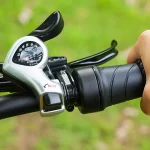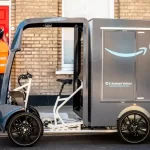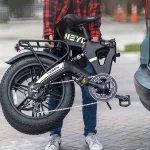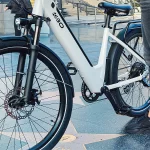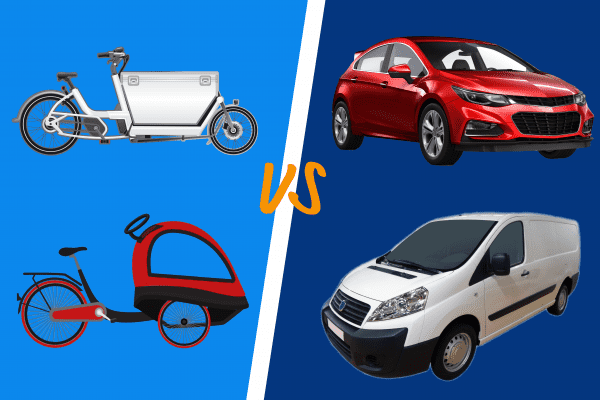
Driving is the go-to method of transport for many people. This is due to the amount of convenience it provides. It’s well known though that driving is not without its problems. These include the harmful environmental impact it gives, parking difficulties and congestion. So what if there was an alternative method of transport that still had a lot of the conveniences of driving, but without the problems it gives? One such method could be getting about on an electric cargo bike.
An electric cargo bike can be a suitable replacement for either a car or a van. You can use one to go shopping, do school runs and to make deliveries. The electric assistance they provide makes it easier to carry big loads and to cycle up hills. Often, electric cargo bikes help you make deliveries and other journey types quicker than vans and cars in city centres. All this whilst reducing congestion, eliminating parking issues and not emitting harmful emissions
Here, in this article, I discuss further about how electric cargo bikes can be a viable car or van replacement. You may not necessarily replace a car or van altogether with an electric cargo bike though. This is due to the fact that an electric cargo bike won’t be suitable for all journey types. These can include especially long journeys for example. However, you may at least be able to replace many car or van journeys with an electric cargo bike.
Table of Contents
Riding Electric Cargo Bikes for Deliveries
Electric cargo bikes are becoming more and more popular for haulage use. In city centres, electric cargo bikes often allow for goods to be delivered quicker than vans. This is as well as saving on the cost of purchasing and maintaining a van for delivery companies.

According to Forbes, a university study found that electric cargo bikes can complete urban deliveries up to 50% faster than small vans. Also, The Guardian, has referred to a study that has found that bikes drop off 10 parcels an hour on average. This is compared to 6 parcels an hour on average for vans. The reasons for this are as below.
- Bikes are far less affected by congestion.
- An increasing amount of dedicated cycle lanes in towns and cities.
- Cycling allows you to take short cuts and more direct routes, not available to motor vehicles. This can include through parks, or alongside canals, for example.
- You don’ t need to spend any time trying to find a parking space. You can usually just park the bike outside the destination. Be sure to sufficiently lock the bike for security though.
- If you have found somewhere to park a van, there may still be a long distance to walk to the delivery destination. This will use up more time compared to if you have parked an electric cargo bike outside the destination.
The below statistic further backs up that electric cargo bikes can help businesses make deliveries quicker than vans in urban situations.
Average speed of driving a car/van in UK city centers – 5mph to 11mph
Average speed of cycling in UK city centers – 10mph to 15mph
Furthermore, a study by INRIX who are a data company specialising in roads, has found that the average UK driver can lose between 90 and 227 hours a year due to congestion in UK cities. This depends on which city though. For example, it’s 90 hours for Coventry and Newcastle and 227 hours in London. Also, again depending on which city, the amount spent each year on petrol stuck in congestion varies between about £700 and £1700 in UK cities. Congestion is not usually an issue for electric cargo bikes. This is due to the fact that you can typically cycle past congested traffic. However, this is providing there’s enough space on the road though, for you to do this.

As a result of the above, delivery companies are increasingly turning to electric cargo bikes. According to the Bicycle Association, 2000 electric cargo bikes were sold for commercial use in 2020. Even larger logistic companies like Amazon and DHL have started using electric cargo bikes. These companies may use an electric cargo bike to pick up goods from an inner city hub, to then deliver to a customer. This article talks about how Amazon has been doing this. Also, this video shows footage of DHL utilising electric cargo bikes.
Obviously, electric cargo bikes are not going to be able to carry all forms of cargo. Particularly extremely heavy and large loads. Nevertheless, for suitable loads, electric cargo bikes are often the way to go. This is particularly in urban environments. Again, they can allow delivery companies to do their deliveries quicker and cheaper. This is also in a more environmentally friendly way. In fact, a recent study in Europe estimates that up to 51% of all freighted goods could be delivered by an electric cargo bike in the future.
Riding Electric Cargo Bikes for School Runs
Many people are now using electric cargo bikes to carry out their school runs. This is great for both the rider and their kids. The rider gets exercise whilst the kids have fun being ridden on a bike. From observing Youtube videos and reading forums, I’ve seen that children really do enjoy being ridden in an electric cargo bike.
There are a lot of electric cargo bikes that readily come with seating for children in the cargo bucket. You’ll find that these cargo bikes will mostly have seating for 2 children. However, some can have seating for up to 4 children. These ones have seating for 2 children at each opposing end of the bucket. With these particular electric cargo bikes, you can usually put the seats down, or take them out. This is to allow for more space, for if you’re using the bucket to store other loads.

These types of electric bikes with child seating in the bucket will usually be a front loader (the cargo bucket being at the front of the bike). However, you may even be able to attach a rear rack on some of these bikes. So, you may even be able to get up to 5 kids on some electric cargo bikes.
There are also electric cargo bikes that readily have the facility to carry kids at the back of the bike. Usually for 1 or 2 kids. They may already have child seats at the back, or there may be a rear rack that children can sit on. You can always attach a separate child seat to a rear rack if the bike does not already come with a proper seat. Always make sure that any child being transported at the back of the bike is secured safely though.
Generally speaking though, front loaders more often give the option to transport more kids, for if you need to. Using an electric cargo bike for the school run can allow you to drop your children off right at the school gate. You can then cycle off to work, or somewhere else like the gym or to the shops.
School Run Safety and Comfort
You may be concerned about safety with regard to using an electric cargo bike for school runs. In which case, you can make sure the cargo bucket has been crash tested. That’s if your bike has a cargo bucket instead of a rear rack. Some of these cargo buckets have an expanded polypropylene (EPP) shell, for extra protection. This is a shock absorbing plastic widely used in the automotive industry for the crumple zones. Also, many of these cargo buckets will have a sturdy metal outer layer. This acts like a roll cage and so provides some impact protection. Additionally, these child seats in the cargo bucket come with seatbelts, usually with 4 or 5 point harnesses for extra safety. You should also make sure your children are wearing helmets when they are being transported on the bike.
For extra comfort, you could consider having full suspension on an electric cargo bike. This will give extra comfort for both you and the children. This will add a lot of extra cost to the bike though. However, without full suspension, it could be uncomfortable for the children if they’re sitting in a cargo bucket, whilst you’re riding on bumpy terrain. This is due to the cargo bucket they’re sitting in, being so close to the ground. Suspension may not be an issue for you though, if the school run route is on smooth surfaces.
School Run Weather Protection
Doing a school run on an electric cargo bike during rainy weather can be unpleasant for children. However, you can often attach a waterproof canopy over the cargo bucket to house the children. This acts like a tent to keep the rain off the children and also keep them warm. These are usually an accessory which you may have to buy separately. Also, they will have zippers for the children to access and will have windows.
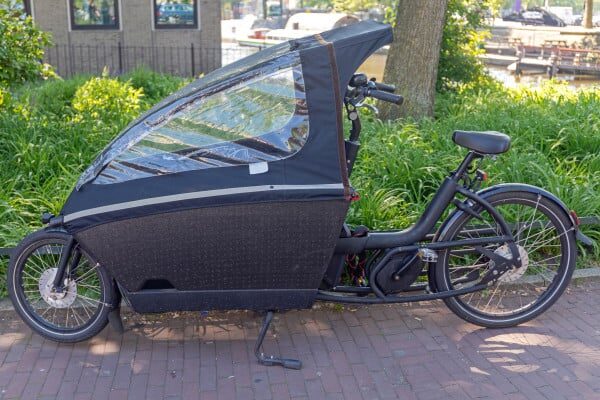
Riding Electric Cargo Bikes for Shopping Trips
Electric cargo bikes come into their own when used for shopping. You can go to the shops and not have the stress of having to look for a parking space. Provided you can find somewhere safe to lock it, you can leave your bike outside, or at least nearby the shop. This saves you time, as well as reducing stress.
Generally speaking, the carrying capacity of cargo electric bikes can vary anywhere from around 100kg to 250kg. You can easily find a lot of electric cargo bikes with a lot of carrying space. Some can have as much as 200 litres of space in the cargo bucket. So, you shouldn’t have any difficulty finding an option that will easily allow you to get your weekly grocery shop. Maybe even your monthly shop depending on how many people are living in your household. Furthermore, if you have a front loader electric cargo bike, you may also be able to attach a pannier rack at the back. This will allow you to carry even more cargo/shopping.

Riding Electric Cargo Bikes for Commuting
Commuting may not necessarily spring to mind as the first journey type that you’d use an electric cargo bike for. This is due to the fact that generally any electric bike would suit this purpose. However, you may already have an electric cargo bike which you use for other journey types. In which case, you can extend its use to the commute as well. This would give you a healthier, more environmentally friendly and more enjoyable commute compared to driving.

As a bonus, you can even use the electric cargo bike to get any shopping done on the way home. This is provided if the shops are on the way home, or if you’re at least able to make a little detour. Here, you’d be able to kill a few stones in one throw. This is by getting to and from work and getting your shopping done, whilst getting regular exercise.
Using an electric bike for commuting allows you to arrive at work without a sweat. This is whilst you’ve still got in some exercise. Again, certainly more exercise than if you’ve been driving. You can even commute back home without the electric assist for more of a workout later. My article “Why Electric Bikes are Ideal for Commuting”, talks further about the use of electric bikes for commuting.
Riding Electric Cargo Bikes for General Trips
Using an electric cargo bike for many trips you may normally use a car for, can make these trips more fun. Cycling relieves stress and anxiety and releases endorphins, known as the happy chemical. This is as well as that you won’t get the frustration of getting held up in congested traffic. You’ll also be getting fresh air as well. All these factors contribute towards electric cargo bikes making day to day chores enjoyable. These chores could be taking the kids swimming or picking something up from the garden centre.
According to license check firm License Bureau, 56% of all car journeys in the UK are less than 5 miles. This figure is a little higher in the US. So this backs up that electric cargo bikes are a viable option to replace cars for many journeys. If your electric cargo bike has seating, you can even use it to give a mate or two a lift.
Riding Electric Cargo Bikes Environmental Impact
A major reason to consider replacing the car or van for an electric cargo bike, is to reduce your carbon footprint. Remember, even if you don’t get rid of your car, you’ll still be reducing your carbon footprint if you at least replace some of your car journeys for the bike. A study by Westminster University showed that current electric cargo bike commercial use in London saves 14,500kg of CO2 a year.
The more you can replace car and van journeys by cycling instead, the more you’re doing your bit to help save the planet from climate change. You can also help reduce congestion and toxic air pollution in your local area. You can reduce your carbon footprint even further by using an energy supplier who uses renewable energy resources (such as hydro and wind) to charge your electric bike.
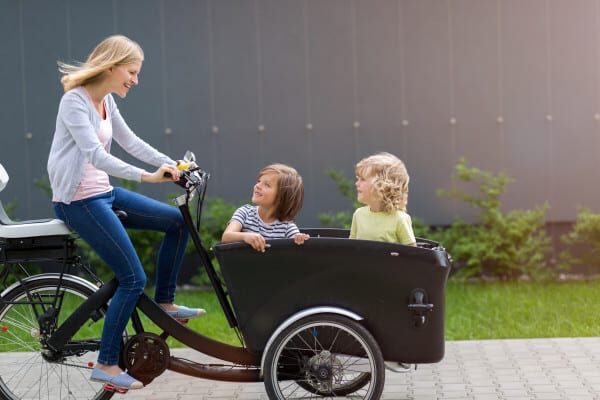
Even if fossil fuels generate the electricity you’re using to charge your electric bike, your carbon footprint will still be far lower compared to driving your journeys. You would only be generating 2.6 to 5 grams of CO2 per mile, as found in a study by the European Cyclists Federation. This is far less than the 1.04kg of CO2 per mile on average for cars. Electric bikes do still have some negative impact on the environment though. This is due to the mining of the lithium used in electric bike batteries. However, this has a much lower impact compared to the CO2 emissions from cars and vans.
Below, shows some further statistics with regard to how much of a positive effect electric bikes have on the environment, compared to cars and vans.
- Using an electric bike instead of a car saves up to 4 tons of CO2 over a 100 day period.
- Electric cargo bikes reduce CO2 emissions by 90% compared to diesel vans and by a third compared to electric vans.
- If electric bikes covered as little as 10% of all kilometers driven in London each year, then that could save up to 130,000 tons of CO2 emissions each year in this city alone.
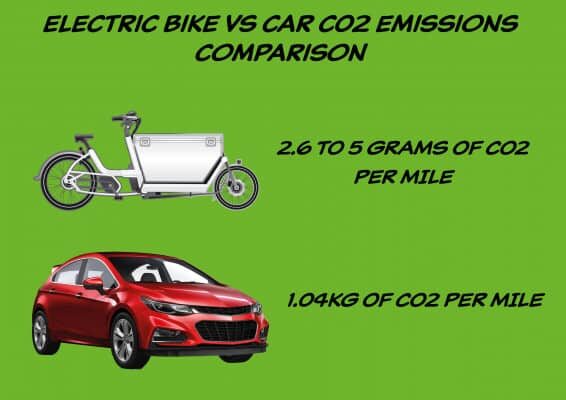
Riding Electric Cargo Bikes Health Impact
What is arguably the best reason for replacing your car for an electric cargo bike is the health aspect. It’s a great opportunity for you to get fit making journeys that you’d make anyway. This is especially helpful if you do not have a lot of time in your schedule for exercise. After all, lack of time is the number one reason why people avoid exercise. Additionally, it’s a great way to get you exercising if you don’t normally have the discipline to do a lot of exercise.
A lot of people think that you don’t get much exercise from electric bikes. This is a misconception though. If you’re using the pedal assist (not using a throttle), then you’re still pedalling. This means you’re still putting in an effort. The electric pedal assist is just amplifying whatever effort you put in. So you can still pedal as much as you like. Below shows a comparison of how much calories you expend on an electric bike compared to a regular bike. This backs up that you’re still burning a decent amount of calories on an electric bike.

The electric pedal assist is especially helpful with electric cargo bikes though. This is due to the help it gives you when you’re transporting heavy cargo loads. The pedal assist can also help alleviate any fatigue that may set in throughout the journey. This is even if the load you’re transporting isn’t especially heavy. Then there’s also the extra help it gives when you’re carrying cargo loads up hills. All in all, this can give you the confidence and ability to use a cargo bike at all, for trips that you would normally use a car, or van for. Again, such as school runs, shopping trips, or general trips where you’re picking something up. This in itself will get you cycling more and therefore get you fitter.
All the time you’re cycling instead of driving, you’re being more active than what you otherwise would be. It’s worth considering that even with an electric bike, if you’re carrying cargo loads, particularly up hills, you’re still going to be expending an effort.
Below shows some of the main health benefits you get from cycling. This is to give you more motivation to use an electric cargo bike instead of a car or a van. By the way, my article “Can You Get Fit on an Electric Bike” talks further about electric bike fitness.
Riding Electric Cargo Bikes Cost Considerations
Electric bikes are cheaper to run than cars by a huge margin. Below shows some of the main running costs involved with a car, which certainly do mount up.
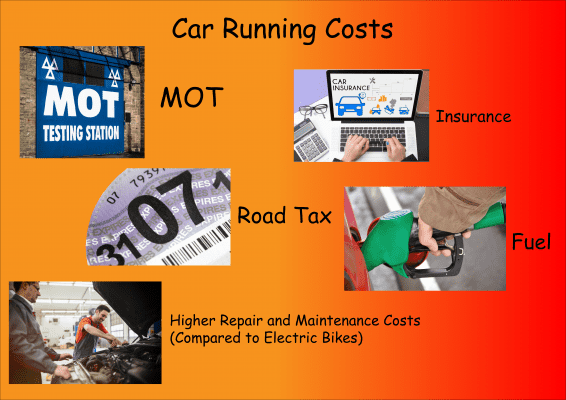
According to insurance company NImbleFins, the average annual cost of running a car in the UK is £3081. This includes £961 a year on fueling the car (for either petrol or diesel) and £484 a year on insurance, on average. With an electric cargo bike, you don’t get most of the car running costs, like having an MOT and road tax. Insurance is optional with electric bikes, but not required by law, like with cars. Even so, bike insurance is cheaper than car insurance. You may have to sometimes pay for maintenance and repairs with an electric cargo bike. But again, this will mostly be far cheaper than the maintenance and repair costs for cars and vans. If not, always cheaper.
Cars and vans will also tend to have a lot more costs that you may not initially think about, compared to cargo electric bikes. These can include costs for valeting, replacement windscreen wipes, engine oil and de-icer, amongst others.
Below shows on average, how the cost of travelling with an electric bike compares to a car in the UK. This is in terms of the cost of both the electricity to charge an electric bike and the fuel to run a car.
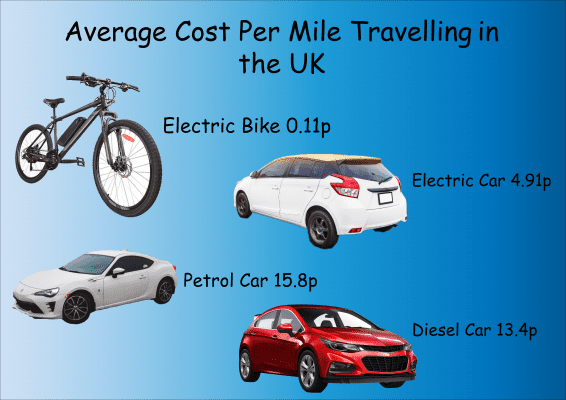
Electric cargo bikes are not cheap, typically costing around £5000/$7000. For the most part though, they are cheaper than cars and vans. However, you may sometimes get some overlap in price, if you get a high end electric cargo bike and a cheap car. For example, if you come by a second hand car. You may possibly have both a car and an electric cargo bike though. Therefore, you’ll still incur car running costs. However, you’ll at least save on fuel and parking costs on the journeys that you use an electric cargo bike instead of a car for.
Some households have an electric cargo bike instead of a 2nd car. These households would have likely saved money by buying an electric cargo bike instead of a 2nd car. Again, this is as well as the lower running cost of an electric cargo bike instead of a 2nd car.
Cycle Routes Can be Quicker than Driving Routes
As mentioned further above, electric bikes can allow you to often get to your destination quicker than cars and vans in urban environments. Again, this is due to the fact that they allow access to shortcuts and cut -throughs. This is as well as that they allow you to dodge congestion.
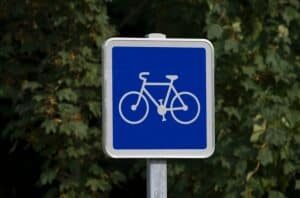
Following from this though, many towns and cities are increasingly becoming more cycle friendly. More and more dedicated cycle lanes and routes are appearing. You can sometimes find out where the best cycle routes are by joining local cycle groups on Facebook and enquiring about these. Members are usually more than happy to help. Furthermore, there’s also a lot of apps and online tools these days that help show you suitable cycling routes. This article from Treadbikely lists some of the best of these route planning apps. Also, some commonly used ones are below.
Bike Route Planning Apps
- Komoot
- Ride with GPS
- Google Maps
- Strava
Riding Electric Cargo Bikes in the Rain
A common reason why some people don’t like to cycle is due to the weather. Normally, when you’re cycling you’re not protected from the elements. However, there are always ways to reduce the impact of this. I’ve already mentioned further above that you can protect children in the cargo bucket from rain, with a canopy. However, with regard to yourself, you can make sure that you wear appropriate waterproof clothing. You can even get dedicated waterproof cycling footwear. There’s also dedicated cycling ponchos which you can buy.
Some electric cargo bikes come with a cover to protect your cargo from rain. For any electric cargo bikes that do not come with a cover for the cargo bucket, you can always buy a cover separately. You can even get covers that cover the whole bike to protect it from rain, for when it’s unattended. This also helps with security as it’s advertising the bike less to potential thieves.

If you’re flexible with your leaving time, you can plan to cycle at times when it’s not raining. There are various weather radar apps that help you to do this. This article from The Weather Station Advisor shows some of the best of these weather radar apps. However, you may sometimes have no choice but to make your cycle journey in the rain. In which case, you could take a change of clothes with you in the cargo bucket (with a cover over). This is as well as wearing waterproof clothing. For further advice on riding electric bikes in the rain, you can read my article “Can I Ride my Electric Bike in the Rain”.
Electric Cargo Bike Security
You may be wondering that it’s all very well using a cargo electric bike to replace your van or car, but there’s always the risk of theft. With the use of a decent bike lock though, or maybe even 2 locks, you can certainly minimise the risk of theft.
U-Locks
A popular bike lock is the U-lock. If you opt for one of these types of locks, you could get one as heavy duty as possible, for maximum security. Therefore, with the U part of the lock being as thick and solid as you can get. This will minimise the chance of thieves being able to break it. However, the heavier duty the U-lock, the heavier it is to carry when you’re cycling. Some manufacturers of U-locks have a security rating throughout their range. For example, Abus rate their U-locks out of 15 for the amount of security they give. Also, with some U-locks made by Abus, the key can double up as the key used to lock and release the electric bike battery.
U-locks may not always be suitable for cargo bikes though. This is due to the nature of the shape and design of cargo bikes. You may not be able to get the bikes’ frame close enough to the object you are trying to lock the bike to, with a U-lock. U-locks come in different lengths though. Therefore, you may need a long one for an electric cargo bike.
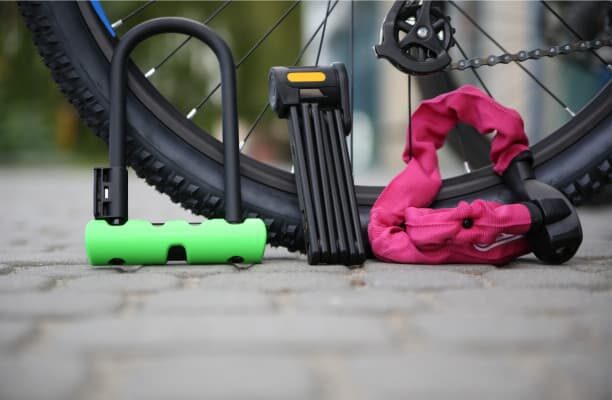 Bike locks including U-lock, folding lock and chain lock
Bike locks including U-lock, folding lock and chain lock
Chain Locks
Chain locks are a particularly suitable way of locking an electric cargo bike. This is due to the fact that they can come in very long lengths. So, you can use a chain lock to lock your bike, if you can’t quite get the bike frame close to the object that you intend to lock it to. Chain locks are also very flexible. This means you can easily get them around difficult angles when locking your bike. Again here, it’s advisable to get as heavy duty chain lock as you can get, to maximise security.
Folding Locks
These have similarities with both a U-lock and a chain lock. They can have the same length as chain locks, but the parts are rigid like with a U-lock. These locks fold up nice and compactly, so they don’t take up much space. This means they are easy to transport whilst you’re cycling. When these locks are in a folded state you turn a key so you can then open them out. Due to the nature of their design, these locks are more flexible than U-locks. This means they’re much easier to manoeuvre round difficult angles, like with chain locks. Some of these locks even have an alarm, to make it more difficult for thieves.
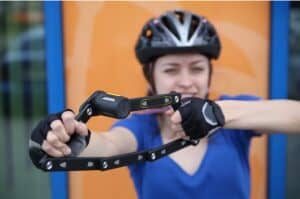 Girl with opened out folding lock
Girl with opened out folding lock
Insurance
As well as locking your bike whenever it’s unattended, you can also have bike insurance. Both using locks and having insurance can give you real peace of mind. Some insurance plans are better than others though. For example, some bike insurance policies do not protect against power tools. Power tools by the way, are a common way for thieves to break bike locks. So if you’re looking for bike insurance, shop around for a decent plan. You may be thinking insurance is an extra cost though. However, bike insurance is still cheaper than car insurance. This is as part of running an electric cargo bike being cheaper than running a car overall.
Extra Security
For extra security, you can always use 2 locks. This makes it more hassle for potential thieves. They’ll be less likely to bother with your bike if they have 2 locks to contend with. If you’re using 2 locks, it’s best if they are a different type to each other. Often, bike thieves may only have a tool to break one type of lock.
A lot of the latest generation of electric bikes have extra security measures built in. For example, some have a lock function where you can remove a head unit from the bike. You can take this head unit with you when your bike’s left unattended. This disables the electric motor. The motor can only be enabled again when you replace the exact same head unit. The value of the bike will be significantly reduced if the motor is useless. This will make your bike far less appealing for potential thieves.

Electric Cargo Bike Storage
A concern with having an electric cargo bike can be where you store it. With cars, you can leave them parked outside in the driveway, or out in the street. With electric cargo bikes though, doing this is riskier, due to the risk of theft. I have spoken about the use of bike locks above, but you may still prefer to store your bike inside for more peace of mind. However, an electric cargo bike may be too big to be kept indoors. Particularly if you live in a small flat. Therefore, generally speaking, the best option to store an electric cargo bike is in a garage, if you have one.
Some apartment blocks have underground/indoor car parks. These are where you only have access if you live in one of the apartments/flats in the building. You could therefore keep your electric cargo inside one of these and you can still lock it. Some of these underground/indoor car parks for apartment blocks even have dedicated bike stands to lock your bike to.
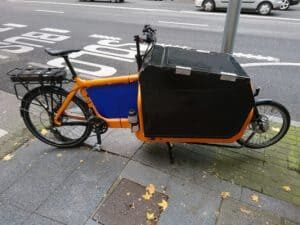
Some electric cargo bikes are designed to stand up right to save space. One of these bikes is the Tern GSD. This can give you an option to store your electric cargo bike indoors. Furthermore, there are all sorts of innovative products on the market to help with cargo electric bike storage. These can include bicyc

Captain Colyer is an expert in sustainable transportation with a Master’s degree in Environmental Engineering. With over 9 years of experience, he is dedicated to advancing eco-friendly commuting solutions. His work focuses on the latest advancements in electric bike technology and promoting sustainable living practices. At ElectricBikePlanet.com, Captain Colyer shares his in-depth knowledge and practical insights to help readers make informed decisions about electric bikes. Join them on their electric journey for the best e-bike advice and recommendations, and connect on Facebook, Pinterest, and Instagram.


